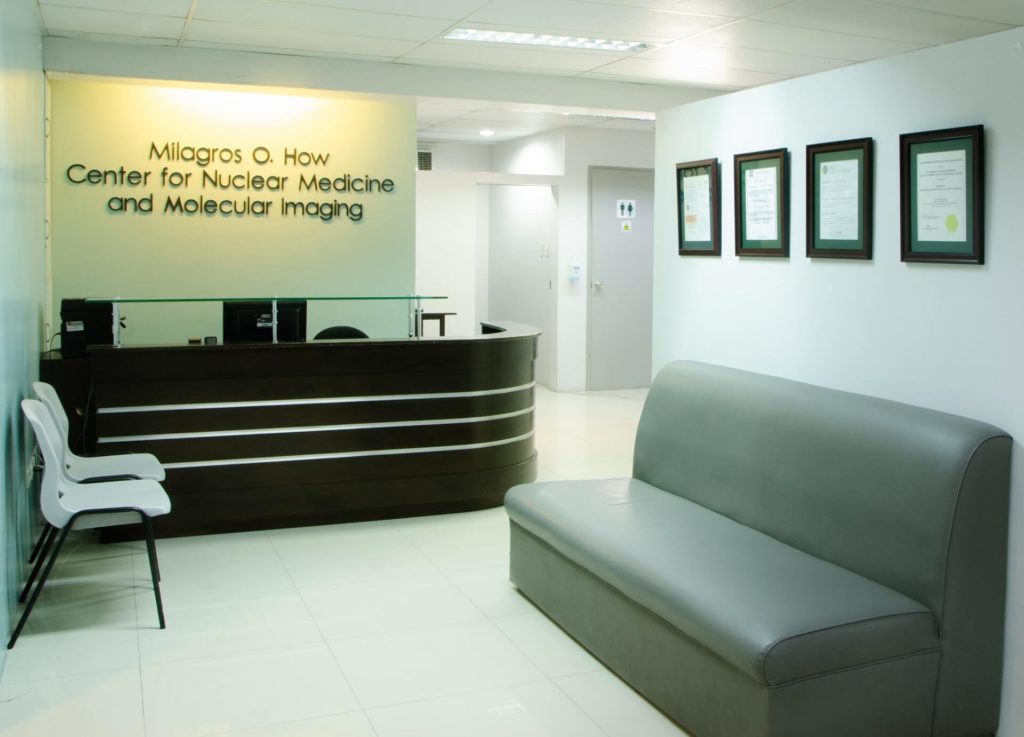Home » Departments » Milagros O. How Center For Nuclear Medicine & Molecular Imaging

MONDAY to FRIDAY – 8:00 AM to 5:00 PM
SATURDAY – 8:00 AM to 1:00 PM
045-625-2999 / 0915-626-6013 / 0942-449-2548 Local 2475
Nuclear Medicine and Molecular Imaging is a specialty that uses very small amounts of unsealed radio labeled compounds which are organ and tissue-specific, given intravenously or orally to document organ function and structure in order to identify abnormalities early in the course of a disease.
It also utilizes radioisotopes for targeted therapies of various benign and malignant diseases and for the detection of antigen-antibody reactions employed in radioimmunoassay test.
1. Myocardial Perfusion Imaging – detection of myocardial ischemia, viable myocardium and myocardial infarction.
2. Radionuclide VENTRICULOGRAPHY MUGA (multigated analysis) for determination of ejection fraction, wall motion and shunt.
Contributes significantly to diagnosis, treatment planning, and the evaluation of response to treatment in patients with cancer.
1. Whole Body Bone Scan & Three- Phase Bone Scan
2. Scintimammography – detection of breast malignancy, an alternative for mammography in patients with dense breasts and those who cannot tolerate the procedure.
3. Whole body iodine scan – evaluation of thyroid malignancies.
Diagnostic nuclear imaging is used to evaluate diseases of the gastrointestinal tract and the hepatic-pancreatic-biliary system.
1. Hepatobiliary Iminodiacetic Acid (HIDA) Scan
2. Sulfur Colloid Liver Scan
3. Gastric Emptying /Reflux Scan
4. Tagged RBC Scan for Gastrointestinal bleeding
Aids in the assessment of renal function, renovascular disease, obstruction and renal scarring.
1. Renal Scintigraphy with In-Vitro Glomerular Filtration Rate (GFR)
2. In-Vitro GFR
3. Captopril Renal Scan for Renal Artery Stenosis
4. Diuretic Renal Scan to detect obstruction.
5. Dimercaptosuccinic acid (DMSA) Scan for Renal Cortical Scanning
Radionuclide imaging in endocrine diseases helps obtain the functional and morphological information on affected endocrine organs especially in thyroid, parathyroid, and adrenal disorders.
1. THYROID SCAN TC99M
2. PARATHYROID SCAN
3. THYROID UPTAKE AND SCAN
4. THYROID UPTAKE MEASUREMENT ONLY
5. MIBG/ Octreotide scans for NET
Dynamic study of tear flow
1. Dacryoscintigraphy
1. Radioactive Iodine Therapy for:
2. Radioactive Iodine Ablation of Differentiated Thyroid Carcinomas and Metastases.
3. Selective Internal Radiation Therapy (SIRT, also called radioembolization) is a targeted treatment for liver tumors that delivers millions of tiny radioactive beads directly to the liver tumors.
SIRT is an approved treatment of liver tumors that cannot be removed by surgery and for those who fail the inclusion criteria of other procedures. These may be tumors that start in the liver (also known as primary liver cancer), or tumors that have spread to the liver from another part of the body (also known as secondary liver cancer or metastases).
4. Metastatic Bone pain palliation using Samarium or Strontium.
A. Thyroid
B. Adrenopituitary
C. Skeletal
D. Diabetes
E. Others
THYROID SCAN PROCEDURES:
CARDIAC SCAN PROCEDURES:
OTHER PROCEDURES:
1. Myocardial Perfusion Imaging – detection of myocardial ischemia, viable myocardium and myocardial infarction.
2. Radionuclide VENTRICULOGRAPHY MUGA (multigated analysis) for determination of ejection fraction, wall motion and shunt.
Contributes significantly to diagnosis, treatment planning, and the evaluation of response to treatment in patients with cancer.
1. Whole Body Bone Scan & Three- Phase Bone Scan
2. Scintimammography – detection of breast malignancy, an alternative for mammography in patients with dense breasts and those who cannot tolerate the procedure.
3. Whole body iodine scan – evaluation of thyroid malignancies.
Diagnostic nuclear imaging is used to evaluate diseases of the gastrointestinal tract and the hepatic-pancreatic-biliary system.
1. Hepatobiliary Iminodiacetic Acid (HIDA) Scan
2. Sulfur Colloid Liver Scan
3. Gastric Emptying /Reflux Scan
4. Tagged RBC Scan for Gastrointestinal bleeding
Aids in the assessment of renal function, renovascular disease, obstruction and renal scarring.
1. Renal Scintigraphy with In-Vitro Glomerular Filtration Rate (GFR)
2. In-Vitro GFR
3. Captopril Renal Scan for Renal Artery Stenosis
4. Diuretic Renal Scan to detect obstruction.
5. Dimercaptosuccinic acid (DMSA) Scan for Renal Cortical Scanning
Radionuclide imaging in endocrine diseases helps obtain the functional and morphological information on affected endocrine organs especially in thyroid, parathyroid, and adrenal disorders.
1. THYROID SCAN TC99M
2. PARATHYROID SCAN
3. THYROID UPTAKE AND SCAN
4. THYROID UPTAKE MEASUREMENT ONLY
5. MIBG/ Octreotide scans for NET
Dynamic study of tear flow
1. Dacryoscintigraphy
1. Radioactive Iodine Therapy for:
2. Radioactive Iodine Ablation of Differentiated Thyroid Carcinomas and Metastases.
3. Selective Internal Radiation Therapy (SIRT, also called radioembolization) is a targeted treatment for liver tumors that delivers millions of tiny radioactive beads directly to the liver tumors.
SIRT is an approved treatment of liver tumors that cannot be removed by surgery and for those who fail the inclusion criteria of other procedures. These may be tumors that start in the liver (also known as primary liver cancer), or tumors that have spread to the liver from another part of the body (also known as secondary liver cancer or metastases).
4. Metastatic Bone pain palliation using Samarium or Strontium.
A. Thyroid
B. Adrenopituitary
C. Skeletal
D. Diabetes
E. Others
THYROID SCAN PROCEDURES:
CARDIAC SCAN PROCEDURES:
OTHER PROCEDURES:

The Angeles University Foundation Medical Center is a non-stock, non-profit world-class healthcare facility located in Angeles City, Philippines.